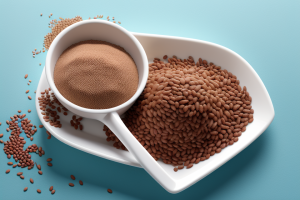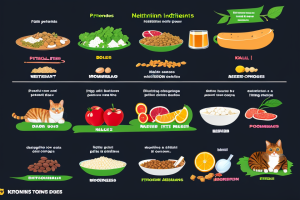Is Grain-Free Dog Food the Best Option for Your Pet?

When it comes to feeding our furry friends, we want to ensure that they are getting the best possible nutrition. One of the most debated topics in the world of pet nutrition is whether dogs should eat dog food with grain. Some argue that grains are an important source of energy and nutrients, while others believe that grain-free diets are the way to go. In this article, we will explore the pros and cons of both options and help you make an informed decision about what to feed your dog. So, is grain-free dog food the best option for your pet? Let’s find out!
The answer to whether grain-free dog food is the best option for your pet depends on various factors such as your pet’s individual dietary needs, allergies, and lifestyle. Grain-free dog food may be beneficial for pets with grain sensitivities or allergies, but it’s important to consult with a veterinarian to determine the best diet for your pet. It’s also important to note that some grain-free dog foods may contain high levels of legumes and potatoes, which have been linked to heart problems in dogs. Ultimately, the best option for your pet’s diet will depend on their specific needs and preferences, and it’s always a good idea to consult with a veterinarian to ensure your pet is getting the proper nutrients.
Understanding Dog Food Labels
What to Look for in a Dog Food Label
When it comes to selecting the right dog food for your furry friend, it’s important to pay close attention to the label on the packaging. Here are some key factors to consider when evaluating a dog food label:
- Ingredient list: The ingredient list is a critical component of the dog food label, as it provides insight into the main components of the food. Ideally, the ingredient list should be dominated by high-quality protein sources, such as chicken, beef, or fish. It’s also important to look for whole, unprocessed ingredients, rather than a long list of additives and artificial preservatives.
- Guaranteed analysis: The guaranteed analysis section of the label provides information about the minimum percentages of crude protein and crude fat in the food. It’s important to note that these figures are based on the as-fed basis, rather than the dry matter basis, which can be a more accurate reflection of the true nutritional content of the food. Additionally, the guaranteed analysis should also include information about the maximum percentage of crude fiber in the food.
- Statements regarding nutritional adequacy: Look for statements on the label indicating that the food is complete and balanced for your dog’s life stage. These statements should be based on the Association of American Feed Control Officials (AAFCO) guidelines, which provide standards for the nutritional adequacy of pet foods. It’s important to ensure that your dog’s food meets these standards to ensure that they are receiving proper nutrition.
How to Interpret a Dog Food Label
When it comes to choosing the right dog food for your furry friend, it’s important to understand how to interpret the label on the packaging. Here are some key things to look for:
- Ingredient list: The ingredient list is ordered by weight, with the heaviest ingredients listed first. This means that the first few ingredients are the most significant in terms of your dog’s diet. Look for high-quality protein sources such as chicken, beef, or fish, and avoid fillers like corn, wheat, and soy.
- Guaranteed analysis: The guaranteed analysis section provides information on the minimum and maximum percentages of crude protein and fat, as well as the minimum percentage of crude fiber and moisture. These values can help you compare different dog foods and ensure that your pet is getting a balanced diet.
- Statements regarding nutritional adequacy: The AAFCO (Association of American Feed Control Officials) statement on the label indicates whether the product is complete and balanced for all life stages or for a specific life stage. This helps ensure that your dog is getting all the nutrients they need for optimal health.
It’s important to note that while the label can provide valuable information, it’s not the only factor to consider when choosing a dog food. Other factors such as the quality of the ingredients, the reputation of the brand, and your dog’s individual needs and preferences should also be taken into account.
The Role of Grains in Dog Nutrition
The Benefits of Including Grains in Dog Food
While some pet owners may believe that grain-free dog food is the best option for their pets, it’s important to understand the role that grains play in a dog’s nutrition. Grains are an important source of energy for dogs, providing them with carbohydrates that are necessary for maintaining optimal health.
In addition to providing energy, grains also serve as a source of fiber for dogs. Fiber is essential for maintaining a healthy digestive system, as it helps to regulate the movement of food through a dog’s gut. A diet that includes grains can help to prevent issues like constipation and diarrhea, which can be uncomfortable for dogs and may lead to other health problems.
Grains are also a source of essential vitamins and minerals for dogs. For example, whole grains like brown rice and quinoa are rich in B vitamins, while wheat contains important minerals like selenium and phosphorus. Including grains in a dog’s diet can help to ensure that they are getting all of the nutrients they need to stay healthy and happy.
While it’s true that some dogs may be sensitive to grains or have food allergies that make it difficult for them to tolerate grain-containing foods, this is not true for all dogs. In fact, many dogs thrive on diets that include grains, and there is no scientific evidence to suggest that a grain-free diet is necessarily better for dogs in the long term.
Ultimately, the best way to determine whether a grain-free diet is right for your dog is to consult with a veterinarian or a certified animal nutritionist. They can help you to understand the specific nutritional needs of your pet and recommend the best diet to meet those needs.
The Risks of Excluding Grains from Dog Food
- Nutrient Deficiencies: When grains are excluded from a dog’s diet, essential nutrients such as fiber, vitamins, and minerals may be lacking. These nutrients play crucial roles in maintaining a dog’s overall health, including supporting digestive health, immune function, and energy levels.
- Limited Options for Budget-Conscious Dog Owners: Grain-free dog foods tend to be more expensive than those containing grains. For dog owners with financial constraints, excluding grains from their pet’s diet may not be feasible, resulting in compromised nutrition or having to switch to lower-quality dog food.
- Financial Exploitation by Pet Food Manufacturers: The trend towards grain-free dog food has led to an increase in the price of these products, with some manufacturers potentially exploiting this trend for financial gain. This can create a challenge for dog owners who wish to provide their pets with the best possible nutrition without breaking the bank.
It is important to note that while grains are a common component of dog food, they are not necessarily essential for all dogs. The optimal diet for a dog will depend on various factors, including breed, size, age, and individual health needs. Therefore, it is always advisable to consult with a veterinarian or a qualified animal nutritionist when making decisions about a dog’s diet.
The Science Behind Grain-Free Dog Food
What Grain-Free Dog Food Is
Grain-free dog food is a type of pet food that does not contain grains such as wheat, corn, barley, or oats. It is becoming increasingly popular among pet owners who are looking for alternative sources of protein and carbohydrates for their dogs. The primary reason for this is that many dogs are intolerant to grains, which can cause digestive issues such as bloating, gas, and diarrhea.
Some grain-free dog foods are made with alternative sources of carbohydrates such as sweet potatoes, peas, and lentils. These ingredients are considered to be more easily digestible than traditional grains and can provide the same energy and nutritional benefits.
Another reason why grain-free dog food is becoming popular is that it is believed to be more natural and closely resembles the diet of wild dogs. Many pet owners feel that their dogs would eat a diet consisting mainly of meat, organs, and bones if they were in the wild. Grain-free dog food is seen as a way to provide a more natural diet for pets.
It is important to note that not all dogs are intolerant to grains, and some grain-free dog foods may not provide all of the necessary nutrients that a dog requires. It is important to consult with a veterinarian to determine the best diet for your individual dog.
The Reasons for Grain-Free Dog Food
There are several reasons why a dog owner may choose to feed their pet a grain-free dog food. Some of the most common reasons include:
- Sensitive stomachs: Some dogs may have a sensitive stomach and have difficulty digesting certain types of grains. Feeding them a grain-free dog food can help reduce the risk of digestive issues such as bloating, gas, and diarrhea.
- Grain allergies: Just like some people, some dogs can be allergic to certain types of grains. Feeding them a grain-free dog food can help reduce the risk of an allergic reaction.
- Grain intolerance: Some dogs may not be able to tolerate certain types of grains, even if they are not allergic to them. Feeding them a grain-free dog food can help reduce the risk of digestive issues caused by grain intolerance.
It is important to note that not all dogs will benefit from a grain-free diet, and some may even suffer from nutrient deficiencies if they are not getting enough carbohydrates from other sources. It is always best to consult with a veterinarian before making any changes to your dog’s diet.
The Evidence for Grain-Free Dog Food
Although the popularity of grain-free dog food has soared in recent years, there is limited scientific evidence supporting the claims that these diets are better for dogs. In fact, some studies have shown that grain-free diets may cause nutrient deficiencies and imbalances in dogs.
One of the main reasons why some dogs thrive on grain-free diets is because they are more digestible than traditional grains. However, this does not necessarily mean that they are better for all dogs. Some dogs may not tolerate certain ingredients in grain-free diets, such as legumes or potatoes, which can lead to digestive issues.
Additionally, many grain-free dog foods are high in protein and fat, which can be problematic for dogs with certain health conditions, such as kidney or liver disease. It is important to note that not all dogs require a high-protein diet, and a balanced diet that includes a variety of nutrients is generally best for overall health.
Overall, while some dogs may benefit from a grain-free diet, it is important to consult with a veterinarian or a canine nutritionist to determine the best diet for your individual dog. It is also important to read labels carefully and choose a high-quality dog food that meets your dog’s specific nutritional needs.
Making an Informed Decision
Factors to Consider When Choosing a Dog Food
When it comes to choosing the right dog food for your furry friend, there are several factors to consider. Here are some key considerations to keep in mind:
- Budget: The cost of dog food can vary widely, with premium brands often being more expensive than standard brands. It’s important to find a balance between quality and affordability that works for you and your pet.
- Dog’s individual needs: Different dogs have different nutritional needs based on factors such as age, size, and activity level. It’s important to choose a dog food that is tailored to your pet’s specific needs.
- Ingredient quality and nutritional adequacy: The quality of the ingredients in dog food can have a big impact on your pet’s health. Look for brands that use high-quality protein sources, whole grains, and vegetables, and that meet the nutritional requirements set by the Association of American Feed Control Officials (AAFCO). Additionally, consider the ratio of protein, fat, and fiber in the food, as well as the level of added vitamins and minerals.
Consulting with a Veterinarian or a Canine Nutritionist
Consulting with a veterinarian or a canine nutritionist is an essential step when considering a change in your dog’s diet. These professionals have the knowledge and expertise to provide personalized advice based on your dog’s specific needs, health history, and lifestyle.
Here are some reasons why consulting with a veterinarian or a canine nutritionist is beneficial:
- Tailored advice: A veterinarian or a canine nutritionist can evaluate your dog’s individual needs, including their age, size, activity level, and any existing health conditions. They can provide customized recommendations that cater to your dog’s unique requirements.
- Navigating pet food labels: The world of pet food can be confusing, with various labels and marketing claims. A veterinarian or a canine nutritionist can help you decipher these labels and ensure that you are providing your dog with a balanced and nutritious diet.
- Expertise in canine nutrition: These professionals have extensive knowledge of canine nutrition and can guide you in selecting the best food for your dog. They can also advise on any potential allergies, sensitivities, or dietary requirements that your dog may have.
- Monitoring your dog’s health: A veterinarian or a canine nutritionist can also monitor your dog’s health and make adjustments to their diet as needed. They can keep track of any changes in your dog’s weight, energy levels, and overall health, and make recommendations accordingly.
Overall, consulting with a veterinarian or a canine nutritionist is a crucial step in making an informed decision about your dog’s diet. They can provide personalized advice, help you navigate the complex world of pet food labels, and ensure that your dog is receiving the best possible nutrition for their individual needs.
FAQs
1. Is it necessary for dogs to eat grain in their diet?
No, dogs do not necessarily need grains in their diet. While grains can provide important nutrients such as carbohydrates and fiber, they are not essential for dogs. Many dogs, especially those with food allergies or sensitivities, do well on grain-free diets. Ultimately, the best diet for your dog will depend on their individual needs and any health conditions they may have.
2. What are the benefits of feeding a dog grain-free food?
There are several potential benefits to feeding a dog grain-free food. For one, it can help reduce the risk of food allergies and sensitivities. Grain-free diets also tend to be lower in carbohydrates, which can be beneficial for dogs who are overweight or have diabetes. Additionally, some dogs may have a better appetite and improved digestion when fed a grain-free diet.
3. Can dogs with grain allergies eat grain-free dog food?
Yes, dogs with grain allergies can eat grain-free dog food. While it’s important to choose a dog food that does not contain the specific type of grain to which your dog is allergic, it’s also important to make sure the food is still nutritionally balanced and meets your dog’s needs. Working with a veterinarian or a pet nutritionist can help ensure that your dog is getting all the nutrients they need in their diet.
4. What are some common grains used in dog food, and are they necessary for dogs?
Common grains used in dog food include wheat, corn, oats, and rice. While these grains can provide important nutrients, they are not essential for dogs. Some dogs may be allergic or sensitive to these grains, and in those cases, a grain-free diet may be necessary. However, it’s important to make sure that your dog’s diet is still nutritionally balanced and meets their specific needs.
5. Can dogs eat too much grain-free dog food?
Yes, dogs can eat too much grain-free dog food just like they can eat too much of any food. It’s important to follow the recommended feeding guidelines on the package and to monitor your dog’s weight and overall health. Overeating can lead to obesity, which can put your dog at risk for a variety of health problems. If you’re unsure about how much to feed your dog, consult with your veterinarian.








